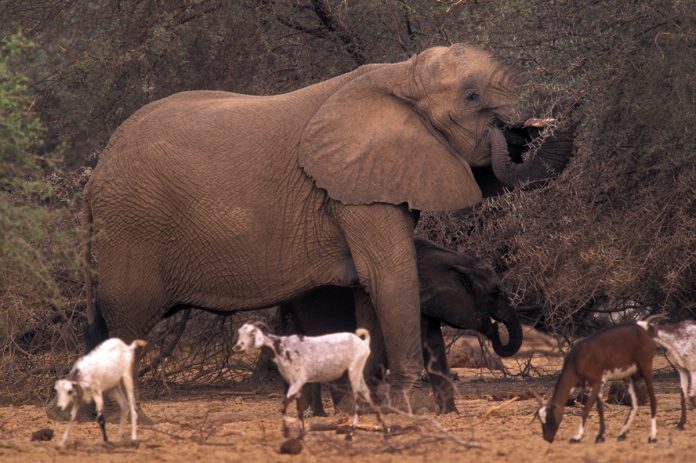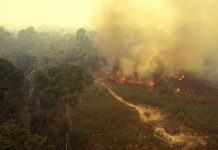Susan Canney, Director of the Mali Elephant Project, WILD Foundation & International Conservation Fund Canada, in the third part of a fascinating discussion about human-elephant coexistence, consider elephants, wildlife and how they help with climate change
At the recent COP26 (26th Conference of the Parties to the United Nations Framework Convention on Climate Change), the term “nature-based solutions” (NBS) garnered particular attention. These are activities that work with nature to address societal challenges, climate change and biodiversity loss simultaneously. Examples range from tree planting to restoration of degraded lands, to improved soil or coast management.
The majority of the world’s nations are committed to implementing them to address climate change, and there have been major funding pledges from the private sector.
This is to be welcomed as a means to repair the damage done to natural ecosystems. A rapidly growing evidence base demonstrates that well-designed NBS can deliver multiple benefits (or “ecosystem services”) such as:
- Flood control.
- Preventing soil erosion.
- Increasing soil fertility.
- Regenerative food production.
- Increased carbon sequestration.
- Water purification.
- Water-table replenishment.
- Restored fisheries.
- Waste management.
- Pollutant removal.
- Pollination.
- Buffering extreme weather events.
- Pest and disease regulation.
- Species protection.
In short, they can contribute to solving several problems at once, but only if they are done properly, in a way that protects and restores intact ecosystems with as close to their full suite of species as possible.
Much of the recent focus has been on tree planting for carbon sequestration. However, purely planting trees does not necessarily equate to establishing a healthy forest with the complex functional web of interactions between species to deliver the required impact. If poorly managed, inappropriate or planted in the wrong place, it can even do more harm than good.
The importance of diverse, complex ecosystems
Highly diverse and complex ecosystems are more resilient to environmental changes and impacts such as storms, droughts, invasive species and disease. They can adapt to changing environmental conditions, buffer against disturbance and extreme events such as fires, pests and diseases, and produce the range of ecosystem services that humans rely on. High soil biodiversity, for example, correlates with increased crop yields and reduced pests.
This includes the conservation and restoration of large wild animals. Wildlife has long been regarded as something we conserve because we like it and feel it has an intrinsic right to exist. These are very valid reasons; however, it leads some to view wildlife as an optional extra, a “nice to have”, almost an expensive luxury that must be set against human development.
This attitude is changing. Research is demonstrating that protecting, restoring, or introducing large animals increases species diversity and ecosystem complexity, not only through their presence, but also through their impacts on vegetation and other species. By disturbing vegetation and soil, large wild animals can create microhabitats that allow new species to establish, facilitating landscape-scale resilience and adaptation to change.
The impact of wildlife on carbon
There are a myriad of specific examples demonstrating the impact of wildlife on carbon. It has been found, for instance, that conserving wildlife is key to the ability of tropical forests to store carbon. The loss of wildlife also reduces forests’ carbon storage capacity by altering the structure and species composition of the ecosystem.
Animals also play an important role in seed dispersal and germination. Elephants are particularly important (especially for large-seeded fruit species), acting like gardeners, transporting seeds over large distances before depositing them in their own little “grow-bag” of dung. Studies have shown that tree species dependent on elephants for dispersal have suffered catastrophic population declines when forest elephants were extirpated. They are also important in making nutrients available for other life and dispersing them across the landscape to fertilise the soil. Studies suggest that the extinction of large animals c.10,000 years ago has led to nutrient deficiency in tropical forests, but this effect has been ignored because most studies have taken place in places where there are no big animals.
Their impacts on vegetation influence the fire regime, soil fertility and the sequestration of carbon in soils. The way herbivores disturb the landscape increases the amount of carbon locked away in hard-to-reach carbon stores. Half the plant material eaten is excreted as dung and urine which is easier for the decomposers in the soil to break down than leaves and wood. Although the decomposers release some carbon dioxide to the atmosphere in the process, most of it is sequestered in the long-term soil reserves.
Elephant impact on vegetation also provides homes for other creatures, such as lizards and birds; their rain-filled footprints provide breeding grounds for amphibians as well as a host of beetles, mites, and other insects; and they dig down to the water below the surface in drylands creating small pools for other species.
In the oceans, it has been proposed that whales impact carbon dioxide emissions in at least two ways. The carbon in their bodies is sequestered away from the atmosphere when they die and stored deep in the ocean. Their faeces and urine fertilise the ocean leading to phytoplankton blooms that capture large quantities of carbon dioxide, claimed by one IMF report to be equivalent to the amount of carbon dioxide captured by four Amazon forests.
Large wild animals require large, interconnected areas. Protecting them indirectly protects the many other species that make up the ecological community of their habitat.
Reverse the decline of the natural world
Successful NBS have been those that use integrated approaches across whole landscapes to conserve, restore and sustainably work with nature through long-term multi-stakeholder partnerships. These combine science with local and traditional knowledge and use participatory approaches that ensure strong community ownership and engagement, as exemplified in the previous articles in this series describing the Mali Elephant Project. NBS are biodiversity-based and explicitly designed to reverse the decline of the natural world, thought to be at least as big a crisis as climate change.
Centuries of overexploitation have created the perception that humanity is somehow distant and disconnected from nature, when in reality we are deeply dependent on nature’s health to safeguard our own. Recognising that humanity and nature are one community with a shared future helps us understand the need to achieve societal goals through aligning human systems with nature rather than in conflict with it.

Ecosystem-wide elephant conservation in the Gourma of Mali through governance that improves local livelihoods in synergy with support to government plans and enforcement strategies project has received funding from the European Union’s Development Fund under the Grant Agreement no. EDF/2018/401-337
Please note: This is a commercial profile
© 2019. This work is licensed under CC-BY-NC-ND.











